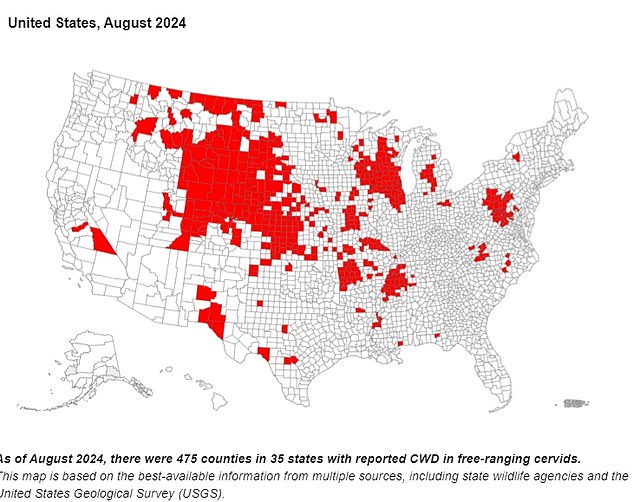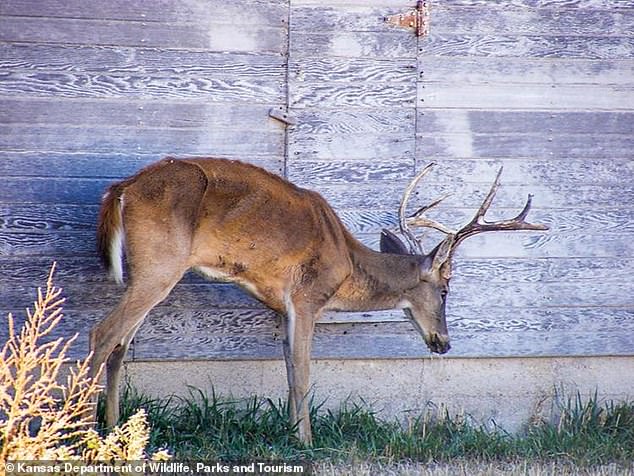New Yorkers are urged to stay away from deer this hunting season after “zombie deer disease” was detected in an animal in the western part of the state.
Authorities confirmed the case of chronic wasting disease (CWD) at an unidentified facility in a northern county on the Canadian border.
This is the first confirmed case of CWD in the state in almost 20 years.
Dubbed “zombie deer disease,” the condition causes parts of the brain to slowly deteriorate to a spongy consistency, causing infected animals to drool and stare before dying.
The condition is 100 percent fatal and spreads among animals such as deer and elk.
It was detected in an unspecified animal as part of routine testing by the New York Department of Agriculture and Markets, but officials do not believe the disease is present in the wild deer population.
The Department of Environmental Conservation added in a statement that “the threat to public health is low.”
However, the department still issued a warning that people should not consume meat from animals suspected of having the disease.
Pictured is a deer showing signs of chronic wasting disease, a 100 percent fatal condition that causes parts of the brain to slowly degenerate to a spongy consistency, leaving the animals drooling and staring before dying.

The CDC map above shows counties where CWD has been detected through August 2024, the latest data available. This includes 475 counties in 35 states.
The statement said that while “there is no evidence that CWD can infect humans, people should not consume meat from infected animals.”
This is the first case of CWD reported in New York since 2005, and most cases in the United States have been reported in Midwestern states such as Kansas, Nebraska and Wisconsin.
The state said it is implementing its Interagency CWD Response Plan. It will increase sampling and monitoring of wild deer and encourage residents to report any sick or dead deer in the area.
CWD is caused by proteins in the body that do not fold into the correct shape called prions.
After infection, prions travel throughout the central nervous system and leave prion deposits in brain tissues and organs.
There are no treatments or vaccines.
The disease is also highly contagious, so if one animal tests positive, the entire herd is considered infected.
It’s not clear exactly how CWD spreads, but animals are thought to spread it by eating food or water contaminated with infected feces or by being exposed to dead bodies.
Direct contact, including saliva, blood, urine, and even antler velvet during the annual molt, can also contribute to transmission.
CWD has never been shown to spread to humans, although some experts fear it is possible.
Earlier this year, a medical journal detailed the cases of two hunters who died from Creutzfeldt-Jakob disease (CJD), a similar disease that affects the brain and has a 100 percent mortality rate.
Like CWD, CJD is caused by misfolded prions and generally affects patients at random. However, the researchers noted that it is possible that hunters became ill after eating infected deet meat.
They wrote: “Although causality has not yet been proven, this group emphasizes the need for more research into the potential risks of consuming CWD-infected deer and its public health implications.”
Research suggests that prions in CWD may bind to elements in the environment and may cause the properties of the prions to change, including the degree of infection of the disease and the potential to infect other animal species or even to humans.
According to the CDC, CWD has been detected in animals in at least 35 states, four Canadian provinces, and four other foreign countries.
Symptoms to watch for in animals include drastic weight loss, stumbling, drooling, apathy, excessive thirst, drooping ears, or lack of fear of humans.
To reduce the risk of CWD, New York state officials recommended deboning deer carcasses hunted outside of New York before bringing them back to the state.
Additionally, carcasses must be disposed of in a landfill rather than outdoors.


